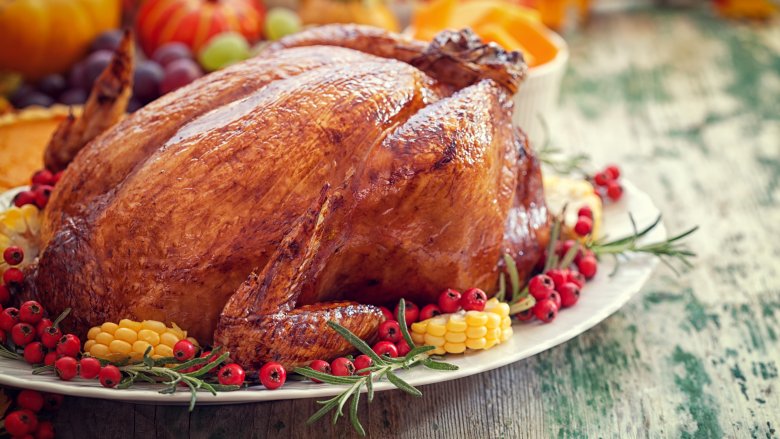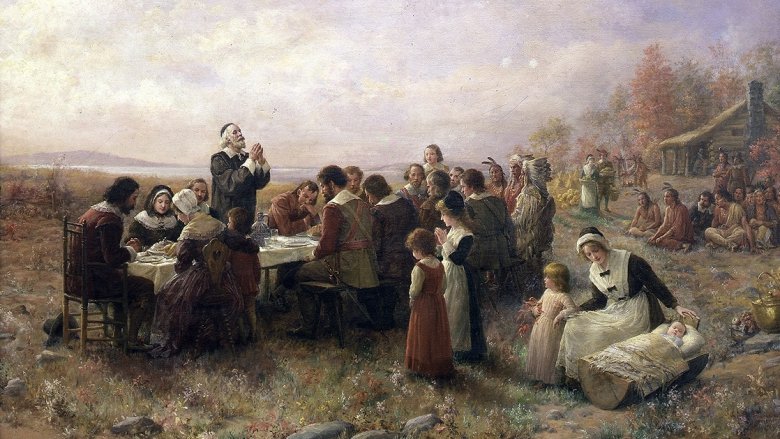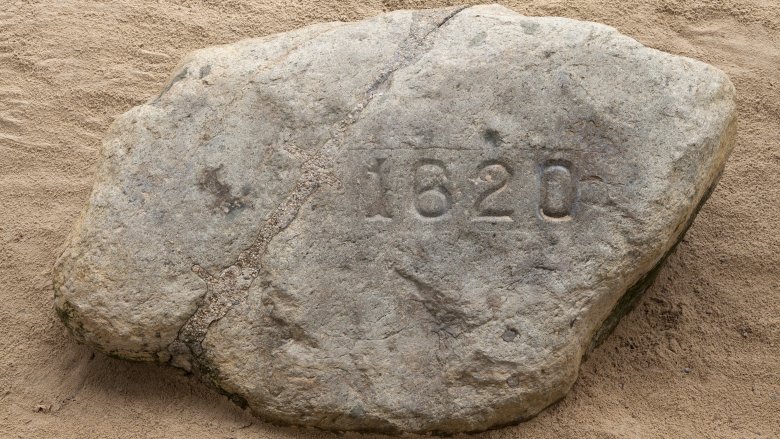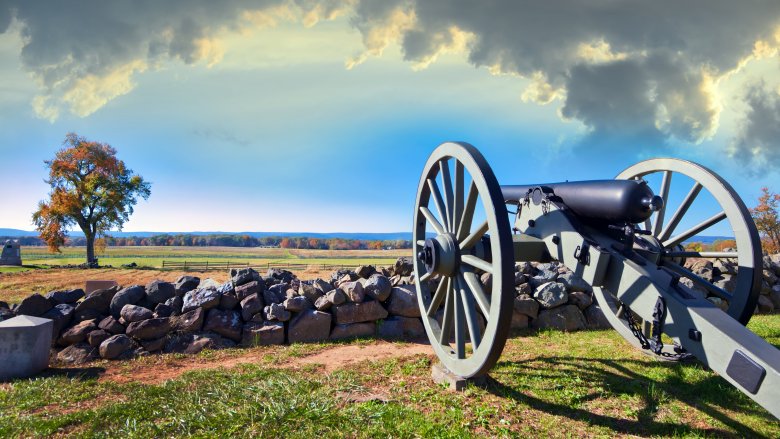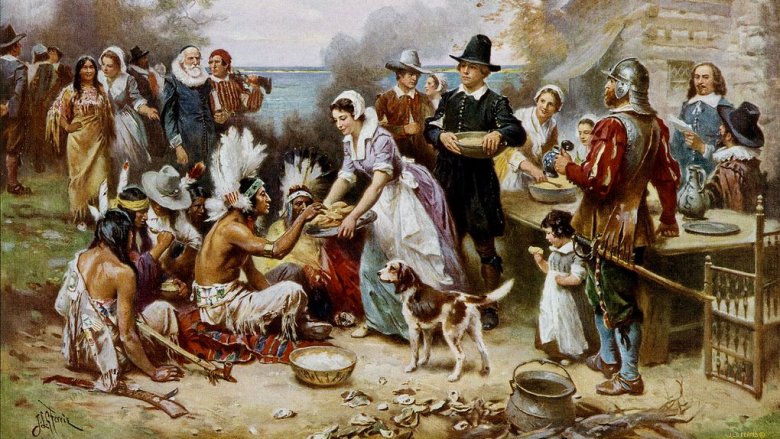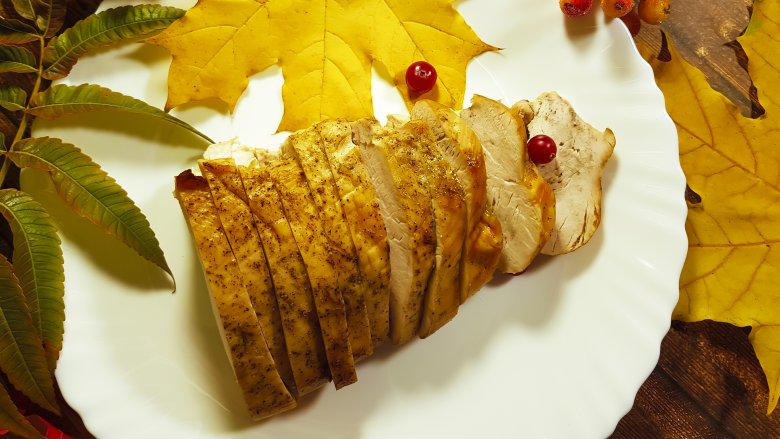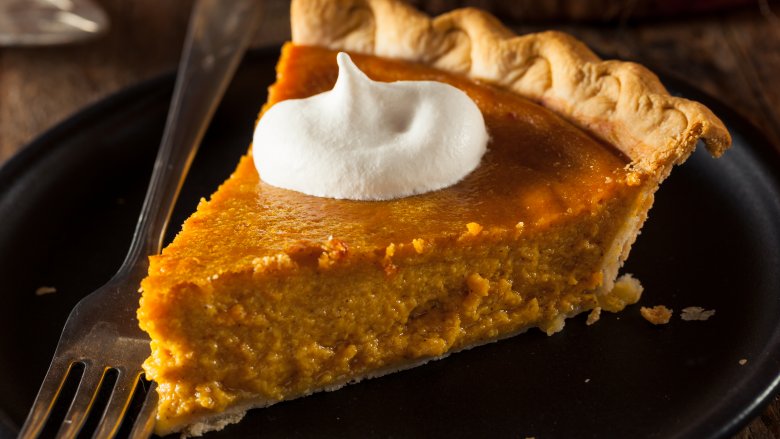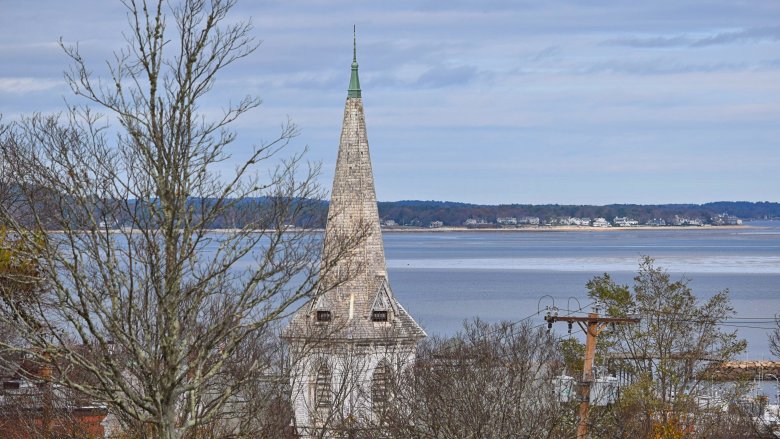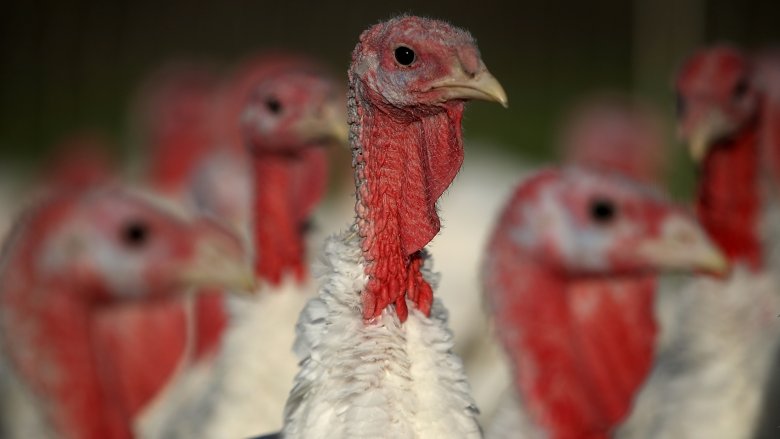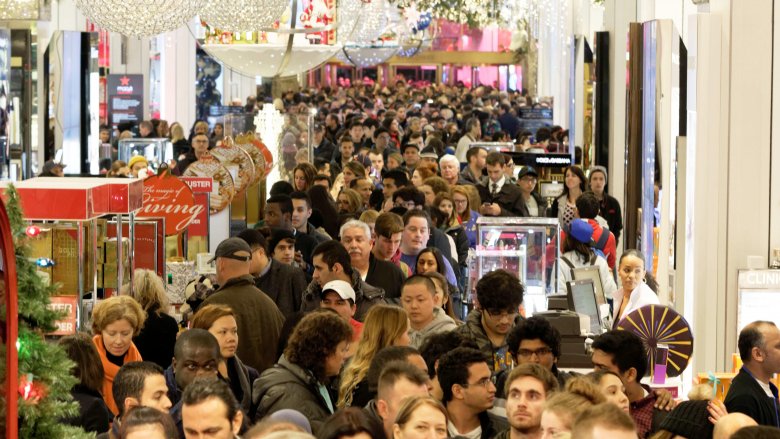False Things About Thanksgiving Everyone Believes
Every tradition has an origin story, and the older the tradition, the less true the origin story tends to be. Deep down, we kind of know that. But we like to believe those stories anyway, because they're fun and whimsical, because we can tell them to our kids in lieu of having actual knowledge, and because sometimes they get us out of having to do the dishes.
Thanksgiving in particular seems so straightforward: It's a celebration of the things we're thankful for, brought to you by the Pilgrims, circa 1621. It's so easy to grasp, you were probably taught about it in nursery school, complete with paper Pilgrim hat or culturally-insensitive Indian headdress. But how much of the original Thanksgiving story is really true, and how much of it is embellished or just plain made up? What about those modern Thanksgiving legends? Does turkey make you sleepy? Is pumpkin pie actually delicious, or have we just been brainwashed into thinking it is? And as long as we can stuff our faces until we can barely move and watch football through half-lidded eyes, does it really matter?
The first Thanksgiving was in Plymouth, Massachusetts in 1621
Every kid with a third grade education knows the first Thanksgiving was in Plymouth, Massachusetts, that it promptly turned into a beloved annual tradition, and that all the turkeys wore hats and were totally cool with being eaten. If it's not taught that way in school, it's pictured that way on whimsical Thanksgiving decorations, in storybooks, and in the things ignorant adults say out loud because that's what they were told when they were third graders.
So for the first bubble on our list of things we plan to prick with the safety pin of facts: The first Thanksgiving — the harvest feast the Mayflower immigrants celebrated in 1621 — wasn't actually called "Thanksgiving." In fact the New York Times says it wasn't until the 1830s that people in New England looked back through history at that three-day harvest festival and said to themselves, "Hey, that kind of sounds like the Thanksgiving bash we've been throwing every year for unrelated reasons. Let's just pretend the two things are the same."
The people of Plymouth did have "Thanksgiving" celebrations but they were religious, churchy things. They were supposed to celebrate something borderline miraculous, like the end of a dry season. They were days of fasting, not feasting, so the word "Thanksgiving" would never have been applied to that secular three-day harvest celebration. And no one would want to celebrate the real traditional Thanksgiving way today, just sitting around not eating piles of stuffing.
The people who threw the first Thanksgiving bash were Pilgrims
If you hopped into a time machine and traveled backward to the first Thanksgiving, which wasn't actually Thanksgiving, and you approached a group of settlers and said, "Hey Pilgrims!" those settlers would look away from you back over their shoulders because they would wonder who the hell you were talking to. Also, they would be a little freaked out by the time machine.
The Pilgrims weren't really Pilgrims, at least not officially. They would not have even recognized that word as one that applied to themselves. According to History, they called themselves "Separatists" or "Saints." In their own writings, they sometimes referred to themselves as "Planters." Later settlers called them "Old-Comers." There were a few uses of the word "pilgrim" in the mid-1600s writings of William Bradford, but the official name change didn't happen until the late 1700s, when excerpts from Bradford's diary finally got enough readers. Even then, the term wasn't necessarily used just for the Mayflower passengers, but for everyone who moved into the Plymouth area during the early 1600s.
So the first Thanksgiving wasn't called Thanksgiving and it was celebrated by Pilgrims who weren't actually called Pilgrims. Makes sense.
Thanksgiving is a celebration of the struggles and triumphs of the Pilgrims
Because we think of Thanksgiving as a Pilgrim thing, we naturally assume that we aren't just celebrating the things that we as modern humans are thankful for — like football, Starbucks, and the brain-sucking electronic devices that are so good at making us forget about all the things we aren't actually thankful for — we are also celebrating the triumphs of the Pilgrims. We're remembering their struggle for religious freedom, their perseverance in a hostile new world, and the bountiful harvest they gathered at the end of that first trying year. Except we're actually not celebrating that at all. What we're really celebrating is the Union victory at the Battle of Gettysburg. So really, all those whimsical Thanksgiving decorations should not feature turkeys wearing black hats with giant buckles on them. They should feature turkeys having their legs amputated in dirty Civil War hospital tents.
According to History, Thanksgiving was first declared an official annual event in 1863, and it was Abraham Lincoln who did it. And he wasn't thinking back to the trials and tribulations of the Pilgrims — he was thinking about recent events. The North had just defeated the South at the battle of Gettysburg, and that's what he wanted America to be thankful for. George Washington suggested a similar day for thanksgiving after the American Revolution, but it wasn't meant to be annual, just a one-off celebration for the new country.
The feast celebrated friendship between settlers and the Wampanoags
It does make for a fine picture, especially for kids, but if you think the whole Thanksgiving "kumbaya with the settlers and their new native friends" shtick you get taught in school seems out of place among all the massacres, crappy land deals, bloody wars, and Manifest Destiny, that's because it is.
According to Indian Country Today, there was some cooperation between the settlers and the Wampanoags, but it wasn't based on them seeing each other as equals. The Pilgrims arrived several years after European-imported smallpox had handily wiped out two thirds of the local native population, leaving their lands in vacant, move-in condition. And the settlers didn't make contact with the Wampanoags until after the first winter, probably because the Wampanoags were all, "We're not going anywhere near those people after what happened the last time."
The Pilgrims eventually befriended a Wampanoag named Tisquantum (popularly called "Squanto,") who showed them how to plant and gather local edibles. But the Wampanoag weren't actually invited to the harvest feast. Instead, it's likely that the natives heard the Pilgrims firing their guns, thus beginning that all-too-American tradition of drinking too much at a party and then grabbing a gun. So the natives thought the Pilgrims needed help, and crashed the party. And by 1636-ish it all went to hell anyway, when the Pequot War broke out. So there's the American history that's pretty much in line with everything that's happened since.
Turkey was eaten at the 'first' Thanksgiving
Turkey is so traditional that the mere suggestion of cooking something else on Thanksgiving is usually met with gasps of scandalized horror, even if it's something sensible like roast beef or ham. And we won't even mention those who want to go completely off the Thanksgiving train with something messed up like a turducken or a vegan lentil loaf, neither of which should be eaten on turkey day, or maybe on any day.
So why is turkey such a tradition on the American table? It's because that's what the Pilgrims ate, right? Actually, no. Or maybe, because they definitely ate a lot of stuff, but even if turkey was one of those thing then it certainly wasn't the centerpiece of the feast. According to Fortune, that honor goes to venison. The Wampanoag brought five deer to the party, and the Pilgrims were all, "Holy crap, venison!" Not really, because they were good religious folks, but venison was a treat because back home in England, it was illegal to hunt deer. The Pilgrims were actually so chuffed about being able to eat venison that they were constantly talking about it in letters, probably ticking off everyone back home where it was still illegal to hunt.
There was other stuff on the menu, too, but we can really only guess what those things were. Shellfish, squash, cornbread, berries, and plums are all likely. No potatoes or cranberries, though. Sorry.
Pumpkin pie was invented by the Pilgrims
First, let's get something straight. Pumpkin pie is not delicious. It's disgusting. Pumpkin is a squash, and squash does not belong in your dessert. Everything you've ever been told about pumpkin pie being delicious is a ruse. If you don't believe this, just pay attention to the way pumpkin pie feels when it's in your mouth. Nothing that texture should be edible.
Anyway. Besides being totally fooled about the edibility of pumpkin pie since you were a small child, here's something else you've been getting wrong about it: Pumpkin pie was not served at the first Thanksgiving because according to What's Cooking America, the Pilgrims didn't have ovens and you kind of need an oven in order to bake a pie. And anyway, if they did have ovens they would almost certainly have baked something not-disgusting like a berry or plum pie, and then America would not have to be tortured with bakeries full of squash-flavored dessert every November.
Even the Pilgrims understood the blech factor of the common pumpkin, but they ate them anyway because when you're hungry you'll eat just about anything. One popular way of eating pumpkin was to slice off the top and fill the insides with milk, honey, and spices, and then bake it in hot ashes, which actually does sound more disgusting than modern pumpkin pie. But that's the tradition that probably led to the pumpkin pie as Thanksgiving's undeserved signature dessert. At least modern whipped cream is an upgrade.
The Pilgrims were celebrating their escape from religious persecution
One reason we admire the Pilgrims so much is that we believe they came to America seeking religious freedom. That first Thanksgiving, then, must have, at least in part, been a celebration of that newfound freedom. Except it wasn't, of course, because otherwise it wouldn't be on this list.
The Pilgrims weren't actually facing religious persecution when they decided to come to America. They were already free of it because they'd fled England 10 years earlier to settle in Holland. But life in Holland wasn't exactly awesome. According to Plimoth Plantation, most of the Pilgrims (who, as you remember, called themselves "Separatists,") worked long hours in the cloth trade for not a lot of money. To make matters worse, their kids were (gasp) starting to think of themselves as Dutch. So after some soul searching, the Separatists decided to move to America, where there would be religious freedom but also economic opportunity, and where they could virtually guarantee that their daughter would never see that hooligan Dutch kid ever again.
The Separatists signed on with a company called "The Plymouth Company" which promised them passage, plus clothing, tools, and other supplies. In return, the Pilgrims had to send natural resources back to England for a period of seven years. As a bonus, the Pilgrims also got to establish their very own totalitarian religion and use it to argue against religious freedom for everyone else. So, yay?
The presidential turkey pardon thing has been around since 1947
One of the most stupid of all holiday traditions is the presidential turkey pardon, which invariably causes journalists to do bizarre things, like bothering to cover the ridiculous practice. Why? Well, it's a cute tradition that's been around since Harry Truman. Except it's not really cute, it's more like morbidly weird and kind of sick in a way. And it's not really even a tradition because it has not, in fact, been around since Truman. We only think it has been because of that one picture of Truman with a turkey. But that photo is misleading — Harry Truman did seem to receive a lot of live turkeys, usually at Christmas and from organizations wishing to kiss some presidential butt like the National Turkey Federation and the Poultry and Egg National Board. But there's no evidence he ever pardoned any of those turkeys. In fact he probably ate them.
According to Snopes, the first president to mention pardoning a turkey was Ronald Reagan, who was cracking a joke. The first official Thanksgiving turkey pardon was pronounced by George H.W. Bush, who declared that the turkey he'd been given for his Thanksgiving table was to live out the rest of his days on a farm, and so a tradition was born. Ironically, most pardoned Thanksgiving turkeys only live for a couple of years because they're bred to be fat and tasty, which means their bodies aren't usually compatible with life.
The turkey coma is not a thing
When your significant other groans that he/she could not possibly help with the dishes because of the turkey coma, know this: The turkey coma isn't actually a thing. That general sleepiness you feel after a big Thanksgiving meal has more to do with how much you ate than what you ate.
According to Live Science, turkey does contain the sleep-inducing amino acid tryptophan, but so do a lot of other foods, like cheese, fish, and eggs. The reason you feel sleepy after a big meal is not because of the tryptophan, at least not tryptophan by itself. It's more to do with the massive amounts of Thanksgiving carbs: The mashed potatoes, bread rolls, and stuffing. When you eat a lot of carbs, your body produces insulin, and the insulin removes amino acids from your body, except, for some reason, tryptophan, which then has free rein to party inside your head. Once in your brain, it forms serotonin and melatonin, which is what makes you want to pass out on the couch and not do dishes.
So really, your significant other can avoid that Thanksgiving coma by not eating like a pig, regardless of what's on the table. But if the love of your life is still insisting that the turkey has an incapacitating effect, you can always threaten to make a lentil loaf next year instead. Fun fact: Lentils have tryptophan in them too, but you don't have to tell.
It's called 'Black Friday' because it's the day when merchants actually start making a profit
One popular myth holds that the term "Black Friday" refers to black ink because it's the day when merchants finally start to turn a profit after a long, hard, broke, rest of the year. (Up until then, supposedly, they've had to do their accounting in red ink, which signifies a loss.) But that's not the only myth about the origins of the name "Black Friday." Another myth says that the day after Thanksgiving is called "Black Friday" because it was the day when people started selling their slaves at a discount, presumably out of some kindness to other slaveholders who needed the extra help preparing the plantations for winter.
According to Snopes, though, the name does not come from the slave trade, thank God, nor does it have anything to do with how profitable stores are in November. It was originally a contemptuous phrase, first used in 1951 by employers who were annoyed that their employees always called in sick the day after Thanksgiving (before it was a common holiday, so basically like the Monday after the Super Bowl is now). A decade later, police were using it, too, to describe the chaos of the first day of the holiday shopping season. Today no one really cares why it's called "Black Friday" as long as there'll be an awesome deal on the new iPhone. Priorities, people.
